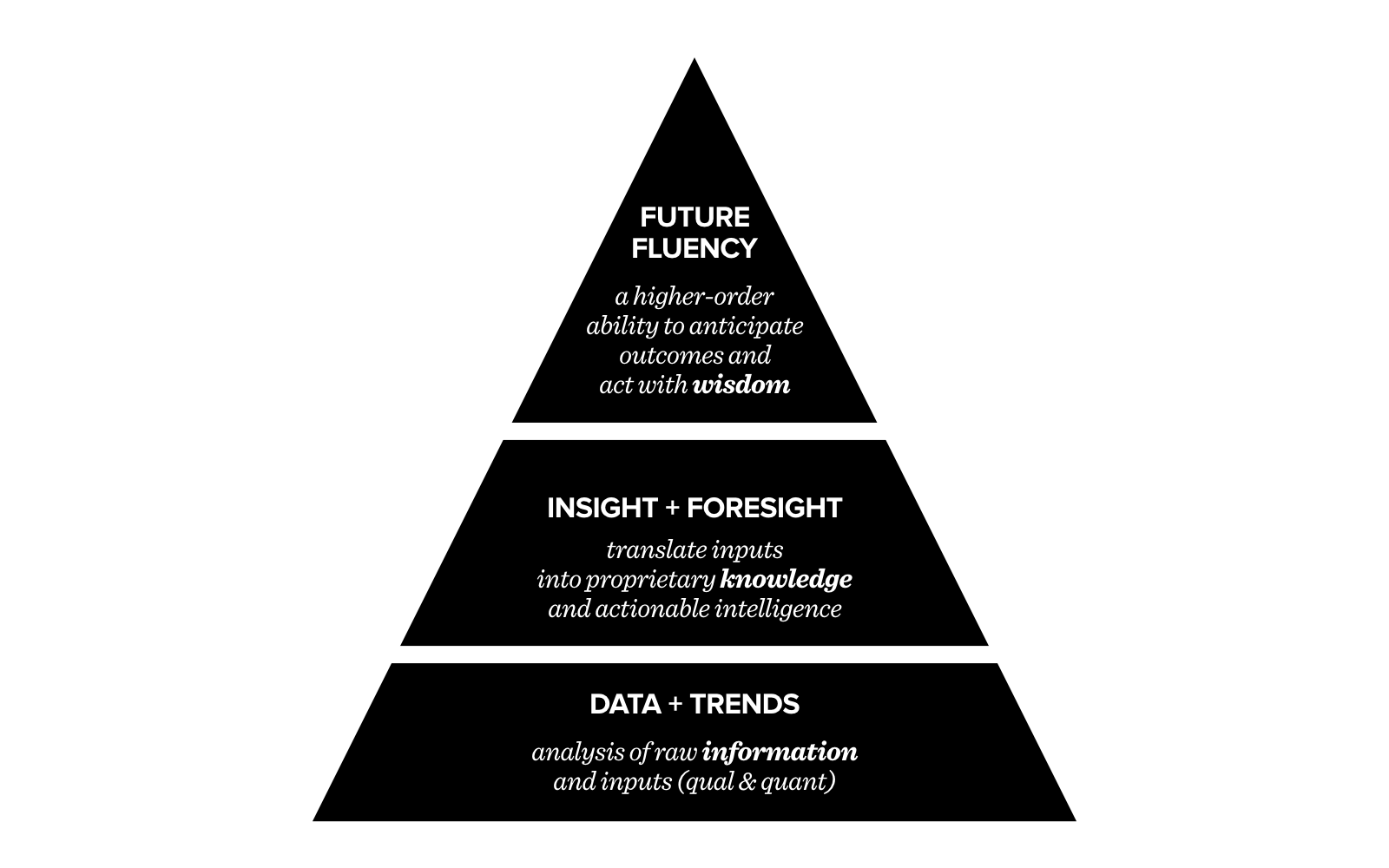In a year of colossal disruption and unrelenting change, we’re all wondering how we might have been more prepared. Looking forward, each of us needs to strengthen our anticipation muscle and “Future Fluency,” says Valerie Jacobs.
The first trends forecast I wrote was back in 2001, a few months after September 11th. I still remember every theme of that report, though back then, I was too young and too new at forecasting to grasp the full extent of the forces at play.
Six years later, I was leading my then-small Foresight team on the development of our yearly broad-level trend report. It was 2007, and in the United States, the year of “bling-bling” culture, Juicy Couture jumpsuits and paparazzi-hungry celebutantes. Facebook was brand new. The economy was roaring, and a new era of “attainable opulence” was taking shape. Despite all this, our team was spotting signals totally counter to what we saw around us. What we found were the signals of a downturn—a trend we titled “Simplistic Slowdown.” At the time, I knew no one would want to hear about it, let alone believe us, so we didn’t share it. But two months into 2008, it was clear that the recession was looming, and new social and cultural feelings were reaching a rapid simmer. Within weeks, we published our report.
If 2020 has taught us anything,
it’s that now is not the time for avoidance.
Trends Speed Up & Slow Down
I’ve thought about these two forecasts often as we wade through the new normal—the next normal, rather—of continued quarantine, virtual living and, now, civil reform. Like then, new social and cultural feelings have reached a rapid simmer (and boiled over) and we find ourselves living in the nexus of major, ongoing change.
Just before Covid-19 hit in early March, we had published our 2020 trends report, forecasting shifts like “Conscious Deceleration,” a desire to slow life way down (similar to 2008’s “Simplistic Slowdown” trend), and “Body Neutrality,” a step beyond body positivity that eschews our physical attributes. Suddenly, mere weeks after publishing our work, we were watching and waiting just like everyone else. And for us, wondering how the novel coronavirus would accelerate or decelerate any of these trends.
Some have slowed, but for the two I’ve mentioned, the pandemic has proven to be an accelerator, deepening their cultural relevance: “Conscious Deceleration” is now a forced deceleration (read: quarantine), and in the new culture of dressed-down Zoom calls, “Body Neutrality” reigns supreme. It’s also of note that for several years, we’ve been tracking the rise of “Radical Inclusivity” and “Collective Advancement,” watching as they became more mainstream in branding, communications and social storytelling. And now, we see the current context giving them more traction, more volume and more empowered voices.
Trends Reflect Where We’ve Been
& Where We’re Headed
I share all of this not to prove that certain forecasts were right or wrong, but to shed light on the nature of trends and the power of foresight. Yes, trends reflect who we are and who we want to become, but they also reveal where we’ve been and how we’ve navigated uncertainty in the past.
It may seem counterintuitive, but in a time when it can feel hard to face what’s right in front of us, it’s even more important to look to tomorrow—to develop what I call Future Fluency. If 2020 has taught us anything, it’s that now is not the time for avoidance. We cannot avoid envisioning the future because of fear, painful truths or a past filled with unaddressed issues. Our current context asks us to revisit past patterns, examine the complexity of today’s driving forces, and bring a new level of personal agency to design the future we really want. Now is not the time for future fatigue. Rather, it’s a chance to embrace the loosened mortar of our mental models and habitual behaviors, converting change into fuel for future vision.

At LPK, we classify trends as cultural information, and foresight as future-forward intelligence—knowledge that fuels a higher-order ability to act upon change. I can tell you first-hand that this knowledge comes with time and practice, taking an iterative approach to trend sensing to develop a sixth anticipatory sense. This skill empowers you to discern what cultural information feels truly new, project how the shift might accelerate or decelerate, then ultimately connect the dots to brand and business implications. This discernment is also a curation exercise, helping you gradually narrow your focus on what trends to monitor, and of those, which you’ll potentially act upon.
Take the crisis of September 2001, or October 2008, or March 2020: it’s one thing to spot the signals of an imminent change, but quite another to translate that potential future into strategic action for yourself, or your business. Herein lies the difference—and the powerful synergy—between trends and foresight, and what it means to be Future Fluent in today’s rapidly changing world.
Trends Are Cyclical-ish
Mark Twain said, “History doesn’t repeat itself, but it often rhymes.” While trends don’t arrive and exit in tidy cycles, they do cycle through with patterns we can learn from.
Remember when I said I remembered every word of my 2001 trends report? It was titled “Sustenance & Continuance.” The theme was spurred by the reaction to 9/11, as well as the changing notion of sustainability, which was moving beyond ecological and scientific circles to more mainstream academia, plus new sectors like design. The primary aspects of the report dealt with heightened feelings of protectionism, biomimicry and looking to nature for solutions and inspiration for resiliency. The trend captured the idea of the “web of life” and, at that time, our newfound connectedness via the world wide web. It was about the power of the web to show us our collective humanity and, finally, the “power of one”—the power of the individual to make a difference.
Thinking about trends as predictions that are either right or wrong is antithetical to the role they play.
I can’t help but sense a similarity to where we are today: a web of self-quarantined individuals, apart yet together, united by our experience grappling with the impact of the pandemic (despite its uneven devastation). These concepts feel as relevant now as they did 20 years ago. Here, the “rhyme,” if you will, is between 2001’s “Sustenance & Continuance” and today’s world—our maintenance of the things that sustain us and help us imagine continuity amidst Covid-19. This mirroring reminds us that we’ve been somewhere similar before, and it offers clues to how we might strategize and prepare for what’s next in the coronavirus crisis.
The same can be said for the justice reform movement we’re currently experiencing worldwide. In striking and poetic effect, this moment in time rhymes with other major milestones in the American Civil Rights Movement: take the March on Washington in 1963, or the following year’s Freedom Summer, staged months ahead of a monumental presidential election. But as this uprising occurs amidst the other sociocultural forces of 2020, we must prepare for something new and unique: this time, the presence of social media allows civilians to organize rapidly and fluidly, capturing images and videos that enable all of us to see the reality—up close and in real time.
Trends Are About Preparedness,
Not Prediction
I often see people spending a lot of time working to “prove” if a given trend will ultimately come to fruition. But thinking about trends as predictions that are either right or wrong is antithetical to the role they play. When we help a business explore trends, it’s not about prediction, but preparedness: prioritizing how to act upon the information (foresight), versus getting bogged down in the information itself (trends).
Those who can flex their anticipation muscle already have a competitive advantage.
Moreover, businesses that are truly Future Fluent also envision the potential behaviors of their competitors, doing future-forward contingency planning that addresses multiple trajectories for a category. You’ll ultimately act on some, but simply “practice” for others.
THE FUTURE FLUENCY MODEL

Flexing New Muscles,
Becoming Future Fluent
Some have penned books and manuscripts that eerily predicted the global pandemic and suggested that we were on the precipice of a resurgence of civil unrest. But it isn’t accurate prognostication that creates Future Fluency. The real skill is readiness for what life looks like—how people feel and function, how businesses operate and respond—in this touchless world gripped by the coronavirus, but also breaking free of confining systems of the past. Those who can flex their anticipation muscle already have a competitive advantage, able to not just embrace the future, but see themselves in it.
This kind of internalization and translation is what helps all of us—brands included—graduate from mere awareness of trends to powerful, decisive action on them.
What Next?
It’s an unprecedented time in so many regards, but if the trends tell us anything, it’s that we move in cycles that ground us and remind us of the strategies we’ve taken before. But the rhyme reminds us that it’s not an exact repeat—that we need to examine other options. Other scenarios, other strategies, other implications. And when you do this, you’ll be more prepared to anticipate the future, navigate the obstacles, seize the opportunities and come out on the other side of change—no matter which future unfolds.








